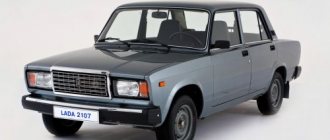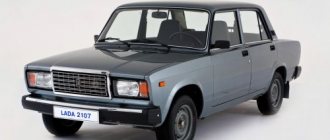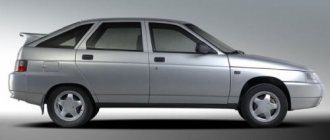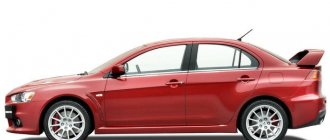10-14 6-9 VAZ
admin 01/12/2017
- Fuel consumption VAZ 2106 1.3l. Real fuel consumption of VAZ 2106 1.3l.
- Real fuel consumption of VAZ 2106 1.5l.
- Real fuel consumption of VAZ 2106 1.6l.
VAZ 2106 is a four-door rear-wheel drive car with a sedan body type. Car production started back in 1976 at the Volzhsky Automobile Plant. Further, the construction of cars was carried out at factories in Syzran and Kherson. Until the model was removed from the assembly line, he was engaged in the creation of Zhiguli in Izhevsk. Production of the VAZ 2106 was stopped on December 28, 2006.
Fuel consumption VAZ 2106 1.3l.
The VAZ 2106 was equipped with a five-speed gearbox and a gasoline carburetor engine with a displacement of 1300 cc. and power 64 hp. The car has a top speed of 145 km/h and accelerates from zero to hundreds in 18 minutes. Fuel consumption within the city is 9.5 liters, and on the highway – 7.6-8 liters per hundred kilometers.
Real fuel consumption of VAZ 2106 1.3l.
- Andrey. Kirov. I inherited a VAZ 2106 produced in 1992 from my father. This was five years ago. Of course, at that time there were practically no “original” spare parts in the car, but the engine worked “like a clock” and never let me down. If you don’t press the gas pedal to the floor on the highway and warm up the car thoroughly in winter, then there will be no problems with it. I think that a domestically assembled engine, with proper and timely maintenance, will last for many more decades. As for fuel consumption, my 1.3 liter engine “eats” about ten liters in the city, and on the highway – within seven liters per hundred.
- Oleg. Tomsk I bought a VAZ 2106 from a neighbor in 2005 with a 1.3-liter engine. The car came off the assembly line back in 1988, so you understand that its condition was not the best. I overhauled the engine, replaced all consumables, slightly modernized the interior and drove it without problems for five years. I was also completely satisfied with fuel consumption: in the city no more than ten liters, and on the highway during normal driving it was possible to keep within 7.5-8 liters.
- Sergey. Adler. I bought a VAZ 2106 from 1985 specifically for taxi work. The previous owner loved his car, so I got it in very good condition. I drove the “Six” for almost seven years and during this time it did not create any special problems for me. If we talk about fuel consumption, then I got about ten liters in the city and eight on the highway.
- Vladimir. Kazan. The VAZ 2106 with a 1.3-liter engine is a good domestic car that, with proper care, can faithfully serve for several decades. I bought my ’85 “six” in 2001 in order to take my family to the dacha and visit relatives. In addition, I also drove the car for work, so it rarely came into my garage. During the entire period of operation, I never looked into the engine, since there was no need for this, it worked properly and did not let me down. In terms of fuel consumption: in the city with normal traffic it was up to ten liters, and on the highway - 8-8.5 liters per hundred.
- Alexei. Ulyanovsk VAZ 2106 1.3 liter - this is my first car. I bought it new off the production line in 2001 and drove it for almost ten years. Of course, immediately after the purchase I had to tighten up a few things and blow out the bottom, but otherwise I had no complaints about the car. The machine is a real “workhorse”; I have no doubts about this during the entire time I used it. In terms of consumption, I can say the following: in the city I got from eight to ten liters, and on the highway (if I didn’t press the accelerator pedal to the floor) - 8-8.5 liters per hundred kilometers.
Tuning
It is possible to tune the 2106 engine because it is a classic engine.
Thanks to this opportunity, you can grind channels, polish intake manifolds, select a carburetor, camshaft, split gears, modify the intake, bore cylinder blocks, select the best options for the piston system, crankshaft, and connecting rod.
It is best to entrust such work as tuning the VAZ 2106 engine to qualified specialists, because this is a serious modification of the engine.
Many motorists want to make their own car more powerful, so they resort to this procedure. To perform tuning of the VAZ 2106 engine, it is necessary to replace specific factory-produced parts with more improved ones. This may include a valve, connecting rod or pistons.
In the process of modifying the car, you can increase the volume in the VAZ 2106 engine. During boosting, it is necessary to take into account the compression and compression ratio of the engine.
Specialists must necessarily assess the current condition of the engine and measure compression. Only after a positive verdict can the volume in VAZ 2106 engines be increased.
DIY tuning in the garage
When a person decides to do tuning with his own hands, he needs:
- Be sure to first check the wiring, which is made of silicone. In almost all cases, it requires urgent replacement. Experts recommend never skimping on wiring and using only high-quality shielded wires.
- Before installation, you need to make sure that the battery and generator have sufficient energy and power.
- To increase engine power, you need to replace the factory generator and rebuild the ignition system.
- You can tune the VAZ 2106 engine at home, but before that you need to watch the lessons and read the relevant manuals. Not every person will be able to assemble the engine correctly and take into account all the details.
Fuel consumption VAZ 2106 1.5l.
VAZ 2106 1.5. It was equipped with a gasoline carburetor engine and a five-speed manual transmission. The engine displacement is 1452 cc and power is 72 hp. Engine torque is 104 Nm at 3400 rpm. The car has a top speed of 150 km/h and accelerates from zero to hundreds in 17 seconds. Fuel consumption VAZ 2106 1.5l. in the city it is 9.8 liters, on the highway - 7.4 liters per hundred kilometers.
Other cars: Renault Traffic fuel consumption
Real fuel consumption of VAZ 2106 1.5l.
- Vladislav. Samara. Six years ago I bought a second-hand “six” with a one and a half liter engine for work and I drive it to this day. What can I say, in my opinion, this is the best car for our roads. In addition, considering that the car rolled off the assembly line back in 1988, its condition can be said to be ideal. If your head “cooks” and your hands grow from the right place, then you can use the “six” for more than a dozen years. In terms of gasoline consumption, my average is ten liters in the city and up to 8.5 on the highway.
- Dmitriy. Kazan. My “swallow”, after a major overhaul in 2001, still doesn’t drive, but flies! I completely overhauled the engine and gearbox, changed all the consumables and slightly modernized the interior. Since then there have been no major problems. In terms of gasoline consumption, I get about ten liters when driving around the city and no more than nine on the highway.
- Egor. Samara. I inherited my “six” with a one and a half liter engine from my father in 1995. My father loved the car very much and looked after it carefully. The machine served me faithfully for ten years, after which I sold it. It seems to me that for our expensive VAZ 2106 it is exactly what we need. The machine is stable, durable, convenient, and most importantly, not expensive to maintain. In terms of gasoline consumption, I got no more than 10 liters in the city (in normal traffic) and up to nine liters on the highway.
- Ivan. Saint Petersburg. I bought the car off the production line in 1993. Of course, for greater comfort and safety I had to tighten some parts and blow out the bottom, but otherwise I was completely satisfied with the car. Playful, easy to control and stable. In addition, the suspension is not very stiff, and the interior is spacious and comfortable. I sold my “six” five years ago and today I already regret it. The car “eats” relatively little, and maintenance costs pennies. My gasoline consumption averaged up to 10 liters within the city and 7.5-8 liters on the highway, which I think is quite normal.
- Victor. Kostroma. I bought a used 1993 Six from a work colleague. What can I say, the car is a real classic of the domestic automobile industry. A spirited engine, a relatively soft suspension, a comfortable interior that warms up quickly in winter. In addition, if the hands grow from the right place, then maintenance costs mere pennies. Fuel consumption is also within normal limits: in the city up to ten liters, and on the highway (if you don’t drive) you can keep within 7.5-8 liters per hundred kilometers.
- Nikita. Moscow. I bought a “six” second hand after a major overhaul. At that time, it already had 7,000 kilometers on it. Today the mileage is 25,000 km, and I still have no complaints about the machine. It picks up speed quickly, has good stability and controllability, and most importantly, is inexpensive to maintain. In terms of gasoline consumption, everything also suits me: in the city with heavy traffic it turns out to be up to ten liters, and on the highway with normal driving you can keep within 8 liters.
- Victor. Stavropol. It seems to me that the “six” with a one and a half liter engine is an ideal car for those who are just acquiring driving skills and are trying to figure out how everything works in the engine, gearbox, etc. The car is easy to control, stable and playful. I’ve been riding mine for five years now and I don’t have any particular complaints, although I bought it used. Gasoline consumption is also within normal limits: in the city I get no more than ten liters, and on the highway, if I don’t drive, it’s 7.5-8 liters.
- Natalia. Belgorod. My husband bought a VAZ 2106 from 1988 from a friend. He said that this is an ideal option for acquiring driving skills. And today I understand that he spoke the truth. We made a capital investment immediately after the purchase, and to this day we have no complaints about the machine. Of course, this is not a foreign car with climate control and leather seats, but the car is quite enough for everyday movement around the city. In terms of gasoline, I get about ten liters in the city and 8-8.5 on the highway.
Other cars: Volkswagen Transporter fuel consumption
Maintenance Procedure
The classic design of the internal combustion engine allows you to get by with simple steps when servicing the engine:
| Maintenance object | Time or mileage (whichever comes first) |
| Timing belt | replacement after 100,000 km |
| Battery | 1 year/20000 |
| Valve clearance | 2 years/20000 |
| Crankcase ventilation | 2 years/20000 |
| Belts that drive attachments | 2 years/20000 |
| Fuel line and tank cap | 2 years/40000 |
| Engine oil | 1 year/10000 |
| Oil filter | 1 year/10000 |
| Air filter | 1 – 2 years/40000 |
| Fuel filter | 4 years/40000 |
| Heating/Cooling Fittings and Hoses | 2 years/40000 |
| Coolant | 2 years/40000 |
| Oxygen sensor | 100000 |
| Spark plug | 1 – 2 years/20000 |
| Exhaust manifold | 1 year |
As the actual life of the internal combustion engine increases, consumables may be replaced more frequently than specified, or operations for cleaning the carburetor, engine, jets, and other attachments may be added.
Motor maintenance
Fuel consumption VAZ 2106 1.6
VAZ 2106 1.6. with a manual five-speed gearbox, equipped with a gasoline carburetor engine with a working volume of 1569 cc and a power of 75 hp. Maximum torque Nm at rpm – 116/3000. The maximum speed of the car is 155 km/h. acceleration from zero to hundreds is carried out in 16 seconds. Fuel consumption: city - 10.3 liters, highway - 7.4 liters per hundred kilometers.
Real fuel consumption of VAZ 2106 1.6l.
- Sergey. VAZ 2106 produced in 1976 is my first car. What can I say, the car is not bad, but it came to me in terrible condition. I made a capital investment, after which I rode it for another seven years. During this time there were no special complaints. If breakdowns did occur, in most cases they were able to be fixed independently with minimal investment. In terms of consumption after repair, it turned out exactly as stated in the passport - no more than 7.5 liters on the highway and a little more than ten in the city.
- Eugene. Astrakhan. I bought a six with a 1.6-liter engine from a neighbor a couple of years ago. The previous owner's car sat in the garage for a long time, so I had to tinker with it. Despite the fact that the car came off the assembly line back in 1984, it is in good condition. Now I also want to repaint the body and install new seats for greater comfort, and I can still ride for at least a hundred years!))) In terms of gasoline consumption, I can say the following: in the city 10-11 liters, on the highway no more than 8.5 liters per hundred.
- Valery. Kostroma. I recently bought a six with a 1.6 engine from a friend. I can only say one thing: you shouldn’t buy such a car after driving a foreign car for several years. On my first trip I almost went crazy! At a speed of 70-80 km/h, everything in the cabin begins to creak and rattle, and when accelerating to 120, it throws the car from side to side. Of course, taking into account the age of the car (1979), you can make a discount, but still... In terms of fuel consumption, of course, everything is more than good: in the city - a little more than ten liters, and on the highway during normal driving you can keep within 8 liters.
- Nikolai. Kaluga. My father gave me a VAZ 2106. This was my first car, which I could not get enough of. I rode an “old lady” made in 1979 for almost seven years and I can say with confidence that this is an ideal vehicle for those who want not only to gain driving skills, but also to understand what and how it works in a car. For gasoline, I got no more than ten liters in the combined cycle.
- Marina. Kazan. My husband gave me a VAZ 2106 from 2000. What can I say: the car is excellent, easy to control and playful. In addition, even the most complex repairs are not expensive, which is also nice. My gasoline consumption is as accurate as it is stated in my passport: 7.4 liters on the highway and 10.3 in the city.
- Denis. Krasnodar. I took a VAZ 2106 produced in 1999 for work. I do repairs and constantly travel to customers, both around the city and beyond. The car suits me perfectly. It is easy to control, stable, with a relatively soft suspension. In addition, even when I load the roof rack with building materials, the speed also develops quite quickly and it pulls well downhill. In terms of gasoline consumption: in the city with normal traffic it turns out to be 10-11 liters, and on the highway, if you don’t drive, you can keep within 7.5-8 liters.
- Oleg. Khabarovsk. The main advantage of the VAZ 2106, as for me, is the ease of repair and maintenance. If the hands grow from the right place, then repairs generally cost pennies. I’ve been driving my “six” for ten years now and I have no complaints about this “workhorse”. Fuel consumption also suits me: in the city I spend a little more than ten liters, and on the highway I get within eight.
- Peter. Rostov-on-Don. My “six” served me faithfully for fifteen years. This car was created for our roads and there can be no doubt about it. Over the entire period of operation, I, of course, replaced the bulk of the “original” spare parts and once made a major overhaul of the engine. But even so, maintenance over the entire fifteen years cost me mere pennies. As for fuel consumption, my “swallow” “ate” about 10.-11 liters in the city and up to eight on the highway.
- Maksim. Chelyabinsk. My father bought a VAZ 2106 2000 from the factory. Of course, I immediately had to go to the service station to tighten the bolts where necessary and blow out the bottom. Otherwise, my father was completely satisfied with the car and drove it for ten years, after which he gave it to me. I want to say this: if you take care of the car, carry out repairs and maintenance on time and drive carefully, then the VAZ 2106 will last at least a hundred years. In terms of gasoline, even today I get it practically, as it is written in my passport: 10.5 -11 liters in the city and 7.5-8.5 on the highway.
- Konstantin. Vladimir. I bought a VAZ 2106 with a 1.6-liter engine to work in a taxi service. I am completely satisfied with the car. The engine works properly, even in severe frosts the car starts with half a turn, repairs and maintenance are not expensive, and gasoline consumption does not exceed the figures specified in the documents: 10.5 liters in the city and 7.5 liters when driving on the highway.
Other cars: Citroen C4 Picasso fuel consumption reviews
About security
By modern standards, the level of safety in the VAZ classic is, frankly speaking, nonexistent, despite the fact that the car was released on the market until 2005. The car does not have any auxiliary electronics, much less airbags. Of the passive safety features, only the front belts, and even those at first came without inertial reels (appeared only in the 90s), so they had to be pulled under the driver manually. For a long time, belts at the rear were not provided for by the design.
In 2002, the Russian magazine Autoreview conducted an independent crash test using the EuroNCAP method. True, the VAZ-2106 was made in Izhevsk, with more modern high seats and a malleable steering wheel. The results, of course, are depressing - 2 points out of 16 possible.
Specifications
Automobile
| brand, model | VAZ-21061 |
| Production | USSR |
| Year of issue | 1982 |
| Body | carrier |
| Type | sedan |
| Number of doors | 4 |
| Number of seats | 5 |
Engine
| Type | gasoline in-line |
| Location | front longitudinal |
| Supply system | carburetor |
| Number of cylinders/valves | 4/8 |
| Working volume, cm cubic. | 1 452 |
| Maximum power, l. With. (kW)/rpm | 77(56.7)/5 600 |
| Maximum torque, Nm/rpm | 106/3 400 |
Dynamic characteristics
| Maximum speed, km/h | 152 |
| Acceleration time to 100 km/h, s | 17 |
Transmission
| Drive unit | to the rear wheels |
| Transmission | manual 4-speed |
Suspension
| Front | independent spring with two levers |
| Rear | dependent spring |
Brakes
| Front | disk |
| Rear | drums |
Dimensions and weight
| Ground clearance, mm | 170 |
| Length/width/height, mm | 4 166/1 611/1 440 |
| Wheelbase, mm | 2 424 |
| Tire size | 175/70 R13 |
| Curb weight, kg | 1 045 |
| Trunk volume, l | 345 |
Fuel consumption of VAZ 2106 with gas equipment
- Vlad. Ekaterinburg. I have a VAZ 2106 1.5 on gas. I had already come across gas equipment for cars before, so I installed it myself at minimal cost. I am completely satisfied with the car both in operation and maintenance. After switching to gas, fuel costs decreased several times, which I am very pleased with. I get about 8.5 liters on the highway and 10-11 when driving around the city.
- Semyon. Pskov. I bought a VAZ 2106 1.3 to work in a taxi service. Despite the fact that the car is over twenty years old, it drives normally, and serious breakdowns are extremely rare. I recently switched to gas and my fuel costs immediately dropped noticeably. During normal driving on the highway I get 8-9 liters, and within the city – 10.5-11 liters per hundred kilometers.
- Alexander. Nizhny Novgorod. I bought a “six” with a one and a half liter engine from a friend and immediately decided to install gas equipment on it. Of course, during the entire period of operation (8 years), I replaced almost all the “original” spare parts, and also repainted the body. There are no special complaints about the car. The car is maneuverable, playful and durable. In terms of gas consumption, I get about 10-11 liters in the city and no more than 8.5 when driving on the highway.
- Stas. Peter. I inherited the “Six” from my grandfather. Grandfather had not driven his car for more than three years, so he had to go through almost everything in it and also repaint the body. To save more fuel, I bought a gas installation, which the guys at the service station installed in just a few minutes. I can say this: if you take care of the car, change consumables and oil on time, then it will “run” for more than one thousand kilometers without serious breakdowns. Today my consumption is no more than 11 liters in mixed mode.
- Basil. Lipetsk. I provide plumbing services, so I simply cannot do without a car. I was looking for a cheap car with low fuel consumption and a friend advised me to buy a VAZ 2106 with a gas installation. I bought a car in excellent condition, right after a major overhaul. I’ve been riding for four years now and have no complaints about my “old lady”. I replace consumables and minor repairs myself, so the cost of maintaining the car is minimal. My gas consumption is low: up to nine liters on the highway and no more than 11 liters in the city.
- Kirill. Ufa. I bought a “six” with a one and a half liter gas engine and in five years I have not regretted it even once. The machine is simply a “workhorse”! I constantly go on long-distance business trips and don’t worry about getting seriously damaged on the highway. If you take care of the car and use it carefully, it will faithfully serve for many decades and will “outlast” most modern foreign cars. With a gas installation, my consumption is within 11 liters in the city and 8-9 on the highway.
What to do if the engine consumes oil after replacing the rings
If, after replacing the rings, the car begins to consume oil abundantly, then the problem in most cases is observed when installing non-original spare parts. Also, specialists always clarify information about the vehicle’s mileage. If the motor has a lot of wear, it means there are leaks.
Instructions:
- valve checking;
- head inspection;
- evaluation of seals;
- Change of oil.
If the above steps help identify an additional malfunction, then it will need to be eliminated. Otherwise, you will have to replace the rings with a more suitable one.
Injection modification
The first in the line of internal combustion engines of the AvtoVAZ manufacturer, the 2106 engine received tuning in the form of distributed injection. At the same time, the owners received a headache:
- intense heating, since the mixture is lean, the manufacturer’s cooling system cannot cope with temperature loads;
- increased fuel consumption up to 13 l/100 km in winter.
Injection 2106
A positive feature is the low budget for major repairs within 10,000 rubles.











